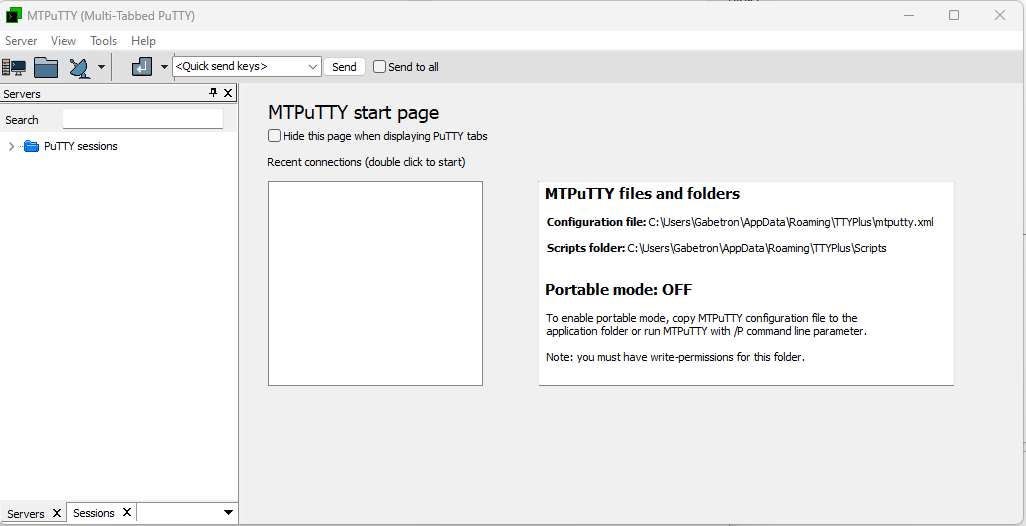MTPuTTY – How to use Multi-Tabbed PuTTY?
Managing multiple SSH connections with Putty can often feel like conducting an orchestra, where each musician (or SSH connection) needs to be individually directed and coordinated to create a harmonious performance. Many IT professionals, navigating the complex world of server management and network administration, face this challenge daily.
Putty, a free and open-source terminal emulator, serial console, and network file transfer application, is a widely used tool for SSH connections. However, when it comes to managing multiple connections, the task can quickly become overwhelming. That’s where MTPuTTy steps in.
MTPuTTy, a free tabbed add-on for Putty, is designed to transform the cacophony of managing multiple Putty sessions into a well-orchestrated symphony. In this guide, we’ll introduce you to MTPuTTy, explain how it works, and show you how it can streamline your SSH connections.
TL;DR: What is MTPuTTy?
MTPuTTy is a free tabbed add-on for Putty, designed to manage multiple Putty sessions in one window, making it easier to switch between different connections without losing track. It enhances efficiency by automating tasks and offering customization options. For a more detailed guide on how to use MTPuTTy, continue reading the article.
Table of Contents
Understanding MTPuTTy
MTPuTTy, at its core, is a free add-on for Putty that introduces a tabbed interface for each connection, much like a web browser with multiple tabs open, each representing a different website. This concept, when applied to Putty sessions, makes switching between different connections seamless, ensuring you never lose track of your ongoing sessions.
In addition to the tabbed interface, MTPuTTy supports all PuTTY protocols – SSH, Telnet, Rlogin, Raw, Serial. This versatility means that no matter your usage of Putty, MTPuTTy can handle it. Further enhancing its adaptability, MTPuTTy provides the ability to control and modify PuTTY command line parameters, allowing you to customize each session to your specific needs.
Highlighted Features
One of the key features of MTPuTTy is its clear, tabbed user interface. But MTPuTTy’s functionality extends beyond just tabs. It also offers the ability to organize your connections using folders. This feature enables you to group related connections together, significantly simplifying the management of large numbers of connections. In essence, MTPuTTy takes the potentially chaotic task of managing multiple Putty sessions and turns it into an organized, streamlined process.
Efficiency Features of MTPuTTy
MTPuTTy goes beyond simplifying your Putty sessions with a tabbed interface. It’s equipped with a suite of efficiency features designed to streamline your workload and minimize time-consuming tasks. Let’s delve into some of these features.
Automation Features
One of the standout features of MTPuTTy is its automation capabilities, including auto login and script running. No longer do you have to manually log into each of your SSH connections or individually run scripts for each session. MTPuTTy takes over these tasks, saving you both time and effort. This feature is especially beneficial when managing a large number of connections, as it significantly reduces the required manual input.
MTPuTTy and PuTTY share configurations and stored connections. This means if you’ve already established connections in PuTTY, you don’t have to start anew when transitioning to MTPuTTy. Your existing configurations and connections are imported into MTPuTTy, simplifying the transition process.
Device Details Saving
MTPuTTy also has a unique feature that allows you to save device details. Once you’ve set up a connection, you don’t have to re-enter the same information every time you want to connect to the same device. MTPuTTy saves these details, further enhancing your efficiency. This feature, in combination with the automation features and shared configurations, makes MTPuTTy a formidable tool for managing multiple Putty sessions.
Installing and Using MTPuTTy
Now that we’ve covered what MTPuTTy is and how it can simplify your workflow, let’s delve into the practical aspects of how to install and use it.
Installing MTPuTTy
Installing MTPuTTy is an easy process:
- Download PuTTy and install it — MTPuTTy is an addon that requires PuTTy be installed already
- Visit the MTPuTTy downloads page and download the latest version of the software. Note that it has a portable application option, which means no installation is required.
- Unzip the downloaded file to your preferred location on your computer.
- Run the MTPuTTy.exe file.
Example of running the MTPuTTy executable:
./MTPuTTy.exe
Congratulations! You’ve successfully installed MTPuTTy.
Using MTPuTTy
One of the standout features of MTPuTTy is that it automatically imports your previous Putty sessions. This means you don’t have to manually recreate each connection. MTPuTTy does the heavy lifting for you, importing all your existing connections and their configurations.
MTPuTTy also provides the option to leave the terminal window open after disconnecting, which can be beneficial if you want to review the output of your session after it’s concluded. You can configure this option in the MTPuTTy settings.
Example of configuring terminal window option:
MTPuTTy > Settings > Terminal > Leave open after disconnect
Another time-saving feature of MTPuTTy is the ability to duplicate sessions, inheriting the credentials and scripts from the source session. This feature is particularly useful if you have multiple similar connections.
User Interface
As for the user interface, MTPuTTy features a left pane that lists your servers for connection, and a right pane that displays your active PuTTY windows. Initiating a PuTTY session is as simple as double-clicking the server name in the left pane. It’s a straightforward, intuitive interface that makes managing your connections a breeze.

Customizing MTPuTTy Settings
One of the distinctive strengths of MTPuTTy is its extensive customization options. MTPuTTy empowers you to remap existing shortcuts and customize behavior on session termination, enabling you to tailor MTPuTTy to your workflow and preferences.
Shortcuts and Session Termination
For instance, if you’re accustomed to a specific keyboard shortcut from another application, you can remap MTPuTTy’s shortcuts to match, smoothing your transition to MTPuTTy and reducing the learning curve. Similarly, MTPuTTy lets you customize what happens when a session terminates. Whether you prefer the terminal window to close automatically or stay open for review, the choice is yours.
Example of customizing session termination behavior:
MTPuTTy > Settings > Session > On session termination > Close window
Send Script Feature
Another potent feature of MTPuTTy is the ‘Send Script’ feature. This feature allows you to dispatch a script or command to multiple remote servers or hosts simultaneously. This can be a significant time-saver when managing a large number of connections.
Portability
Perhaps one of the most unique features of MTPuTTy is its portability. MTPuTTy can be set up to run from a USB flash drive, allowing you to carry your sessions with you wherever you go. Here’s how you can do it:
- Copy the MTPuTTy.exe file to your USB flash drive.
- Run MTPuTTy with the /P parameter. This will create a configuration file in the same folder.
- Start MTPuTTy from your flash drive.
Example of starting MTPuTTy from a flash drive:
./flash_drive/MTPuTTy.exe /P
Thanks to these customization options and features, MTPuTTy not only simplifies managing multiple Putty sessions but also makes the process more efficient and personalized.
Security and Script Execution in MTPuTTy
While MTPuTTy’s efficiency and customization features are certainly noteworthy, it’s equally important to consider the security implications when using the software. After all, security should always be a priority when managing SSH connections.
Security Practices
The MTPuTTy team recommends leaving the password field empty when setting up connections. Rather than storing your password in the software, you should manually enter it in the PuTTY window each time you connect to a server. While this might seem like an extra step, it adds an additional layer of security. Not storing your password helps reduce the risk of it being exposed if your system is compromised.
Script Execution
In addition to security, there’s another crucial aspect to consider when using MTPuTTy: script execution. If you’re leveraging the automation features of MTPuTTy to run scripts, it’s important to configure a delay before script execution. This delay ensures that the script doesn’t start running before the connection is fully established, potentially leading to errors or incomplete script execution. By configuring a delay, you ensure that your scripts run smoothly and accurately every time.
Example of configuring a delay before script execution:
MTPuTTy > Settings > Scripts > Delay before script execution > 5 seconds
The Benefits of MTPuTTy
As we’ve explored throughout this guide, MTPuTTy offers a suite of features that make it an essential tool for managing multiple PuTTY sessions. Let’s take a moment to recap the key benefits of MTPuTTy and why it might be a valuable addition to your IT toolkit.
Streamlined Connection Management
Firstly, MTPuTTy simplifies managing multiple connections. Thanks to its tabbed interface and folder organization, tracking all your connections in one place becomes effortless. No more juggling multiple PuTTY windows or losing track of which session is which. With MTPuTTy, everything is neatly organized and readily accessible.
Cost and Availability
In terms of availability and cost, MTPuTTy is free to use and readily available for download. This makes it a cost-effective solution for IT professionals seeking to streamline their workflow without incurring additional expenses.
Part of a Larger Ecosystem
But MTPuTTy isn’t just a standalone tool. It’s part of a larger ecosystem of free tools for IT professionals. When used in conjunction with other tools like PuTTY, MTPuTTy can help create a comprehensive, efficient, and cost-effective IT management system.
Productivity Gains
Perhaps the most significant benefit of MTPuTTy is the potential productivity gains. By automating tasks like login and script running, MTPuTTy can save you a significant amount of time. As we all know, in the world of IT, time is a precious commodity. With MTPuTTy, you can spend less time managing connections and more time focusing on the tasks that really matter.
Conclusion
In summary, MTPuTTy is not merely an add-on for PuTTY, but a comprehensive tool that offers a range of features designed to enhance and streamline your SSH management process. With its tabbed interface, folder organization, automation features, and customization options, MTPuTTy is crafted with the user’s efficiency and convenience in mind.
The most compelling reason to consider MTPuTTy is its potential to significantly boost your productivity. By reducing the time and effort required to manage multiple PuTTY sessions, MTPuTTy allows you to concentrate on more critical tasks. In the fast-paced world of IT, any tool that can save time without compromising on performance is a valuable asset.
Whether you’re an IT professional managing a network of servers or a developer dealing with multiple SSH connections, MTPuTTy is a tool worth considering. Its blend of efficiency, customization, and security features make MTPuTTy not just a useful tool for PuTTY users, but a game-changer in the realm of SSH connections.

